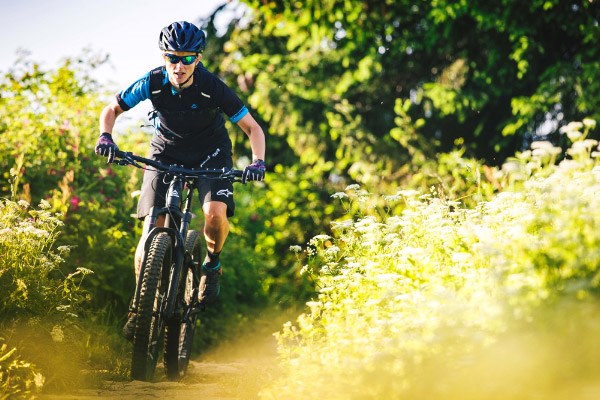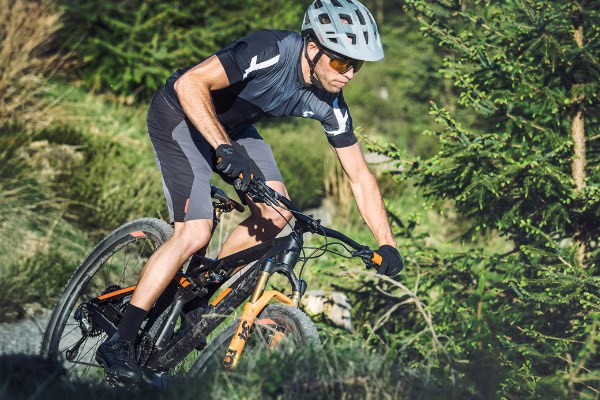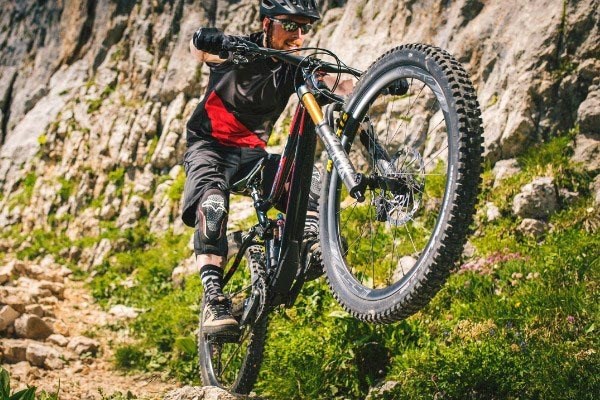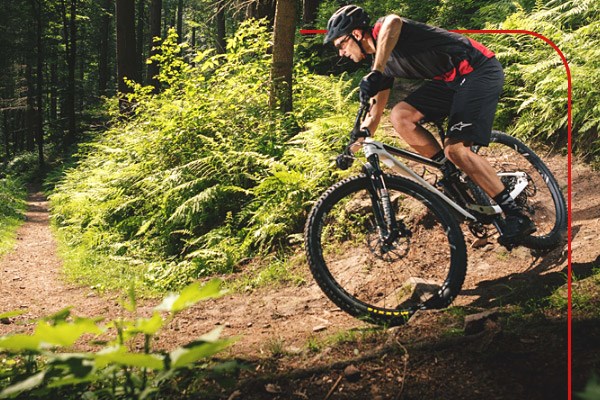Hardtail and full suspension trail mountain bikes are built for riding the type of trails that are most popular with MTB enthusiasts. These are the kind of tracks that you’ll find at most trail centres as well as in your local woods. Trail bikes are best for this kind of riding. We’ll examine typical features in this trail mountain bike guide, as well as covering all the different types of trail bike, so you know what to look for when choosing your next MTB.
Common Features of a Trail Bike
Whether it’s a hardtail or full sus there are some things that are common to all trail bikes. The geometry is more relaxed than a cross country bike. This makes them more stable on the descents, so you can ride challenging terrain faster with more confidence. Wide handlebars and short stems improve control and add to the confident ride feel.
Dropper seat posts are common on trail bikes. Lowering the saddle on the descents gives you much more control as you can move your body around freely on the bike. it’s the opposite on the climbs as you’ll want your saddle up for efficient pedalling. Dropper posts add a lot to the enjoyment of the ride as they allow you to raise and lower your saddle without needing to stop and fiddle with your seatpost.
Most trail bikes have one-by drivetrains with a single front chainring and wide range rear cassette. This makes shifting nice and easy as well as helping to keep the chain in place when you’re riding rough terrain. Twelve speed drivetrains offer the widest range of gears. You get plenty of low range gears for the climbs while still having enough of a high range for the fast descents. Disc brakes are standard on trail bikes, large rotors and 4-piston callipers offer the most stopping power.
You can choose between a hardtail or a full suspension trail bike. Hardtails are more affordable while full sus bikes offer a smoother ride. Hardtail s are faster on smooth terrain while full sus bikes are quicker on rough terrain and give you more confidence when the going gets tough. Both are fun to ride. We go into this in more detail in our hardtail vs full suspension guide.
Types of Trail Mountain Bike
Trail bikes span the gap between lightweight cross-country bikes and big hitting enduro rigs, so there is a lot of variety within this category. While you can ride a trail mountain bike on almost any type of terrain, some are more suited to particular types of riding than others. A good way to tell the difference between different types of trail bike is to take a closer look at the suspension travel numbers.
110mm of suspension travel
Trail bikes with around 110mm of suspension travel tend to be the lightest which makes them ideal for long distance off-roading. Short stems, wide handlebars and dropper posts are paired with lightweight frames and fast rolling tyres.
These bikes combine the plus points of both cross-country and trail mountain bikes. This makes these bikes good for trail centres as well as XC adventures. If cross-country riding is more your thing have a look at our cross-country mountain bike guide.

130mm of suspension travel
Mountain bikes with around 130mm of suspension travel sit squarely in the trail centre mould but are still lightweight enough for longer distance riding. With modern geometry and capable components these bikes are capable on challenging terrain and can be more fun to ride on mellower trails than longer travel bikes.
There are some really exciting 29ers in this category that are defying some of the preconceptions around shorter travel trail bikes with their incredible capabilities and fun focused ride feel.

150mm of suspension travel
At the upper end of suspension travel in the trail bike category are the bikes with 140mm – 150mm of suspension travel. These MTBs are capable enough to take om much more challenging terrain without feeling ‘over biked’ on mellower tracks. As well as beefier suspension the tyres on these bikes tend to be more aggressive than those on shorter travel trail bikes.
These are the machines for those who like to take on more challenging tracks but still want a bike that is fun to ride at the trail centre. If you want to take on even more challenging trails have a look at our enduro bike guide.

Which wheel size is best for trail bikes: 29” or 27.5”
The wheel size debate is a lot less polarized than it used to be. It is no longer true that one is seen as being better than the other for a particular type of riding. There are performance differences between the two wheel sizes, but bike fit and feel also play a major role in rider preference.
Bigger wheels are faster rolling than smaller wheels once up to speed. The larger diameter of 29” wheels helps them to roll over bumps in the trail more easily. These wheels are quicker over both smooth and rough terrain. 29” wheels also require a little less suspension travel to smooth out rough trail sections. You also get a larger tyre contact patch with a 29” wheel compared to a smaller wheel with the same tyre width. This means that 29ers offer more grip on the trail than 27.5” bikes.

While 29ers might be faster once they get going, smaller wheels are quicker to accelerate. This means that it is easier to get 27.5” wheels up to speed. Another advantage of the 27.5” wheels is that they are more manoeuvrable. This is because smaller wheels are easier to turn and the frame can also be made smaller, especially at the back end. This is an especially useful trait on tight twisty tracks.
Another important thing to consider is how these two wheel sizes relate to frame and bike size. 29ers are great for taller riders as the frame proportions offer a better fit. If you are a smaller rider however you might find that the smaller 27.5” wheeled bike offer a better fit. Some riders find that the back wheel buzzes their rear when riding steep descents.
The 27.5” wheeled bikes are still the most popular but 29ers are catching up fast.








